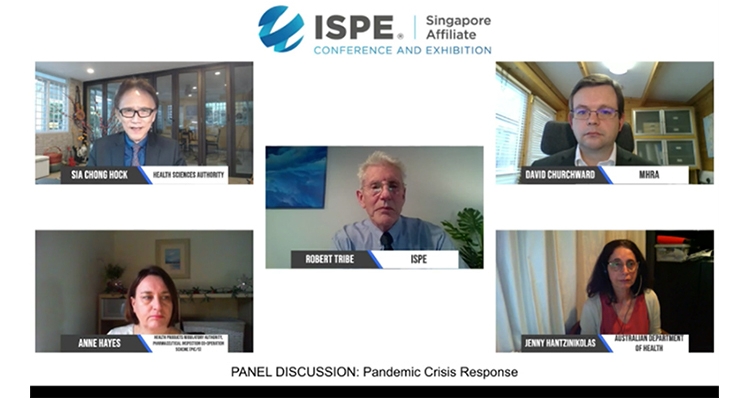Regulators from HPRA, HSA, MHRA & TGA Discuss Distant Assessments

At the ISPE Singapore Affiliate’s 20th Anniversary Conference on 9-12 December 2020, four international regulators discussed how regulatory authorities and industry were responding to the COVID-19 pandemic crisis.
The regulators on the panel were:
General Question for each panelist:
Each panelist was asked for their opinion on:
- What lessons have you learned from the COVID-19 pandemic?
- Which of these lessons have worked well and should be retained when the pandemic ends?
- Which of these lessons have not worked well and could be improved upon?
There was a common theme in the responses from each of the regulators, including:
- The pandemic had provided an opportunity for regulators to think outside the rule book and introduce some flexibility in the way regulatory requirements were implemented, but without compromising patient safety.
- Distant assessments can be done quite effectively despite challenges for both inspectors and industry, but with the same outcomes achieved.
- Distant assessments should be continued when the pandemic ends, but in hybrid form (remote plus on-site). In fact, PIC/S discussed this topic at its recent training Seminar on “Distant Assessment of GMP Compliance” and is considering the benefits of the hybrid inspection model being undertaken jointly by inspectors from several different PIC/S member authorities.
- What has not worked well, particularly in the early stages of the pandemic, has been the video conferencing platforms, internet connectivity and inappropriate audio/visual equipment. But each of these have gradually improved over time.
While the panelists were answering these general questions, the audience was polled for their opinions.
- Is hosting a distant assessment easy for manufacturers? 36.4% answered yes, 63.6% answered no.
- Should distant assessments continue after the pandemic ends? 72.7% answered yes, 27.3% answered no.
All panelists agreed that distant assessments involve a lot more planning and preparation for both industry and inspectors, with challenges concerning information technology (IT), live streaming, having the right people available, interpreters, etc.
David Churchward indicated that one of the benefits of IT platforms for MHRA, once properly established, was that it had enabled MHRA inspectors to inspect inside equipment such as fluid bed driers via remote cameras; obviously, inspectors cannot be put inside such equipment.
Audience Questions:
Terminology
An audience question asked whether the terms “Remote Inspections”, “Distant Inspections”, “Desktop Inspections” & “Virtual Inspections” were the same, or whether there were subtle differences.
Jenny Hantzinikolas indicated that these terms needed clear definitions because there were subtle differences between different regulatory authorities.
Anne Hayes said that this topic was discussed at the PIC/S virtual Seminar on Distant Assessments and a PIC/S Working Group will probably be formed to work towards developing agreed definitions for these terms.
Drug Shortages
An audience question asked whether work is being done to harmonize the drug shortage procedure and the definition for essential medicines.
David Churchward indicated that there needs to be an enabler to agree on what a shortage is and to decide on a harmonized definition for essential drugs.
Anne Hayes said that an EU Task Force on the Availability of Medicines (human & veterinary) had already been established and was working on a harmonized procedure. She said that the International Coalition of Medicines Regulatory Authorities (ICMRA) would be an obvious organization to work on this from an international perspective.
Mutual Recognition Agreements (MRAs)
An audience question asked whether there will be a system of information sharing for inspections of COVID-19 vaccine manufacturers despite the EU/US MRA excluding vaccines.
Anne Hayes indicated that although the EU/US MRA excluded vaccines, there will be elements of reliance amongst regulators for these inspections using, where possible, the PIC/S GMP Inspection Reliance initiative.
Jenny Hantzinikolas said that Australia’s MRAs (with EU, NZ, Canada, Singapore & Switzerland) included vaccines, so information sharing was routine.
Sia Chong Hock said that Singapore’s bilateral MRAs (with Australia and New Zealand) also included vaccines. However, because the multi-lateral ASEAN MRA on GMP Inspections did not cover biopharmaceuticals and vaccines, information sharing was not possible and separate inspections would be needed, unless the vaccine manufacturing facility was located within an ASEAN Member State has been successfully inspected by a reliable/trusted benchmarked authority.
David Churchward said that most regulatory authorities would use a pragmatic, risk-based approach for determining the GMP status of a COVID -19 vaccine manufacturer. This would involve building an overall compliance picture from information gathered via the PIC/S GMP Reliance Initiative, remote inspection, etc.
Disclaimer
This is brief and informal synopsis of discussion among regulators from various countries and regulatory and other organizations during a panel dialogue at the ISPE Singapore Affiliate’s 20th Anniversary Conference on 9-12 December 2020. It has not been vetted by any agency or regulator and does not represent official guidance or policy of the regulatory agencies and organizations cited in this article.







